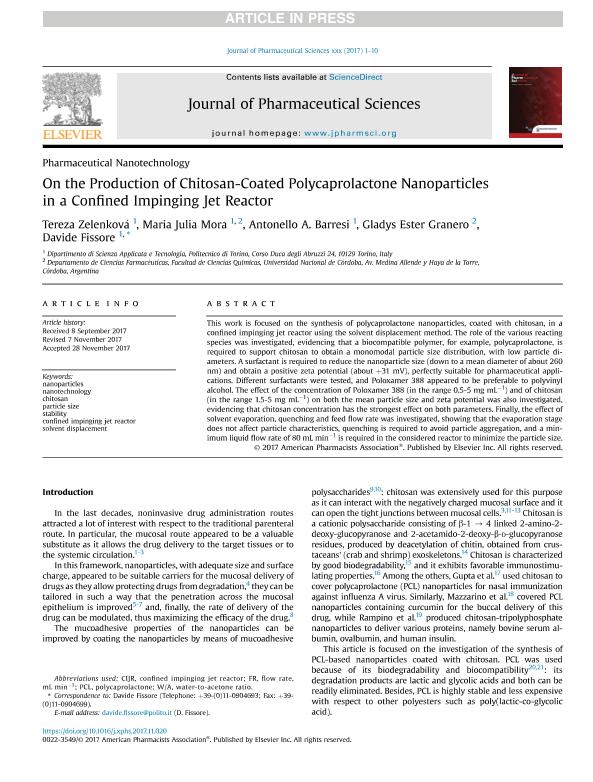Artículo
On the Production of Chitosan-Coated Polycaprolactone Nanoparticles in a Confined Impinging Jet Reactor
Zelenkova, Tereza; Mora, Maria Julia ; Barresi, Antonello A.; Granero, Gladys Ester
; Barresi, Antonello A.; Granero, Gladys Ester ; Fissore, Davide
; Fissore, Davide
 ; Barresi, Antonello A.; Granero, Gladys Ester
; Barresi, Antonello A.; Granero, Gladys Ester ; Fissore, Davide
; Fissore, Davide
Fecha de publicación:
04/2018
Editorial:
John Wiley & Sons Inc
Revista:
Journal of Pharmaceutical Sciences
ISSN:
0022-3549
Idioma:
Inglés
Tipo de recurso:
Artículo publicado
Clasificación temática:
Resumen
This work is focused on the synthesis of polycaprolactone nanoparticles, coated with chitosan, in a confined impinging jet reactor using the solvent displacement method. The role of the various reacting species was investigated, evidencing that a biocompatible polymer, for example, polycaprolactone, is required to support chitosan to obtain a monomodal particle size distribution, with low particle diameters. A surfactant is required to reduce the nanoparticle size (down to a mean diameter of about 260 nm) and obtain a positive zeta potential (about +31 mV), perfectly suitable for pharmaceutical applications. Different surfactants were tested, and Poloxamer 388 appeared to be preferable to polyvinyl alcohol. The effect of the concentration of Poloxamer 388 (in the range 0.5-5 mg mL−1) and of chitosan (in the range 1.5-5 mg mL−1) on both the mean particle size and zeta potential was also investigated, evidencing that chitosan concentration has the strongest effect on both parameters. Finally, the effect of solvent evaporation, quenching and feed flow rate was investigated, showing that the evaporation stage does not affect particle characteristics, quenching is required to avoid particle aggregation, and a minimum liquid flow rate of 80 mL min−1 is required in the considered reactor to minimize the particle size.
Archivos asociados
Licencia
Identificadores
Colecciones
Articulos(UNITEFA)
Articulos de UNIDAD DE INVESTIGACION Y DESARROLLO EN TECNOLOGIA FARMACEUTICA
Articulos de UNIDAD DE INVESTIGACION Y DESARROLLO EN TECNOLOGIA FARMACEUTICA
Citación
Zelenkova, Tereza; Mora, Maria Julia; Barresi, Antonello A.; Granero, Gladys Ester; Fissore, Davide; On the Production of Chitosan-Coated Polycaprolactone Nanoparticles in a Confined Impinging Jet Reactor; John Wiley & Sons Inc; Journal of Pharmaceutical Sciences; 107; 4; 4-2018; 1157-1166
Compartir
Altmétricas



